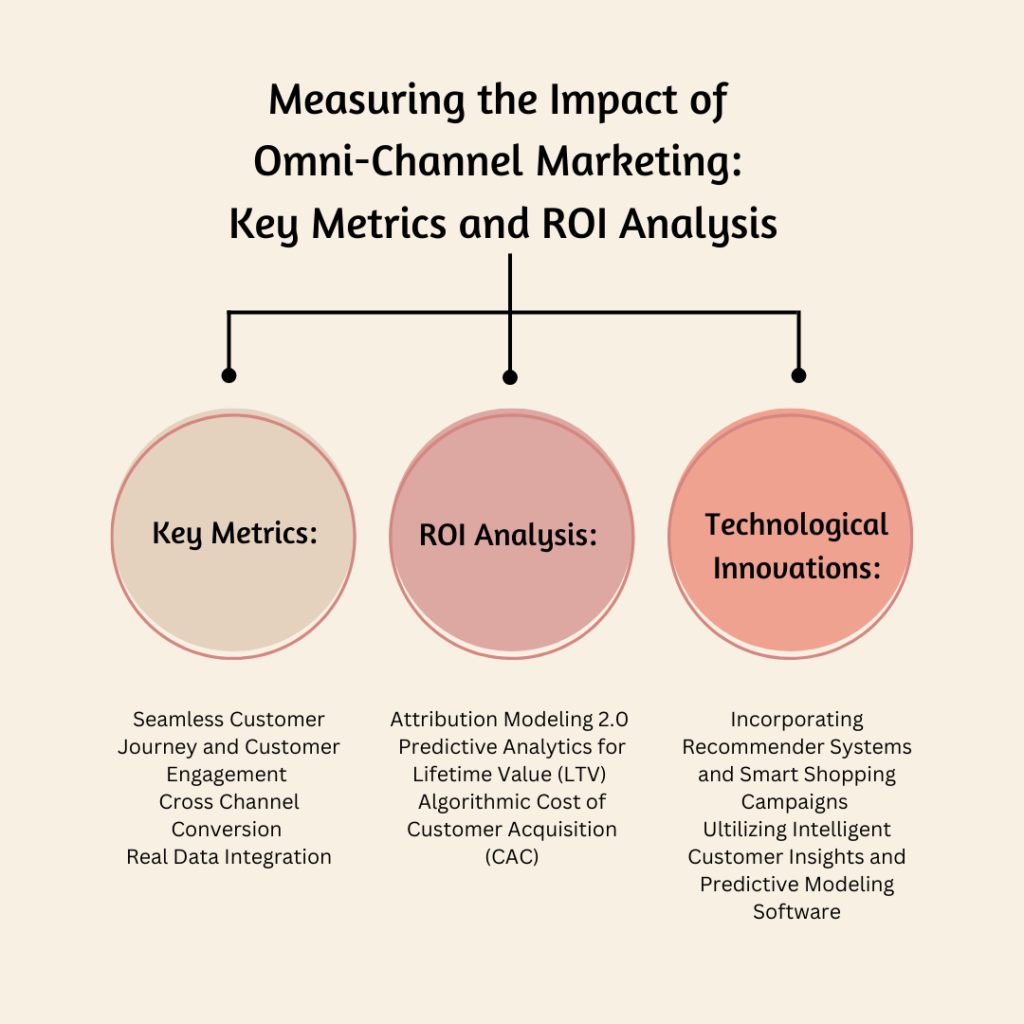Measuring the Impact of Omni-Channel Marketing: Key Metrics and ROI Analysis
In the rapidly evolving landscape of digital marketing, businesses are navigating a complex web of channels to connect with consumers. And, among the strategies gaining increasing prominence – stands Omni-Channel Marketing, a multifaceted approach that integrates diverse channels for a seamless customer experience. The pros of creating an omnichannel marketing strategy are clear. Data shows that marketers using three or more channels earn a 287% higher purchase rate than those using a single-channel campaign. Against this backdrop, the article explores the pivotal role of key metrics and ROI analysis in deciphering the impact of Omni-Channel Marketing on today’s tech-driven market. Let’s get going.
Understanding the Technological Tapestry of Omni-Channel Marketing
The last few years forced several companies to start thinking outside the box and accelerate their omnichannel strategies. For example, many brands began exploring the benefits of direct mail to stand out from competitors online. Since 67% of consumers think direct mail feels more personal than the internet, it holds a crucial spot in any multichannel strategy.
Omni Channel Marketing is a technological tapestry that interlaces various digital and physical touchpoints, creating a unified customer journey. This strategy encompasses a spectrum of channels, including online platforms, mobile applications, brick-and-mortar stores, and more. At its core, Omni Channel Marketing leverages technology to synchronize and personalize customer interactions, providing a cohesive brand experience regardless of the chosen channel.
Also, the channels you use and the metrics that come with them depend on your industry. For example, in the real estate sector, your primary focus might revolve around enhancing response rates. For individuals in the financial industry, emphasizing customer engagement is pivotal, while retail businesses may prioritize monitoring incremental sales and customer retention rates.

Key Metrics: Decoding the Technological Pulse of Omni-Channel Marketing
1. Customer Journey Consistency:
The technological underpinning of Omni Channel Marketing lies in ensuring a seamless customer journey. Cutting-edge analytics tools track user interactions across channels, enabling businesses to identify patterns and inconsistencies. A unified, consistent journey indicates successful technological integration, whereas deviations point towards areas for optimization.
2. Advanced Customer Engagement Analytics:
The advent of artificial intelligence and machine learning has empowered businesses to delve deeper into customer engagement. Advanced analytics tools assess click-through rates, sentiment analysis, and user behavior to quantify engagement levels. These metrics provide a nuanced understanding of how customers interact with digital touchpoints, enabling precise adjustments to enhance engagement.
3. Cross-Channel Conversion Analysis:
In the realm of Omni Channel Marketing, the ability to analyze conversions across diverse channels is paramount. Technological tools employ attribution models and advanced analytics to dissect the customer journey, attributing conversion values to each touchpoint. This granular insight empowers businesses to optimize their marketing strategies, allocating resources where they yield the highest returns.
4. Real-Time Data Integration:
The real-time integration of data from various channels forms the backbone of Omni Channel Marketing’s technological prowess. For instance, unified data can lead to a 10% increase in employee productivity. Hence by tracking and improving efficiency and productivity metrics, such as average handling time, first-contact resolution rate, or agent utilization rate, an omnichannel contact center can demonstrate its success in optimizing resources and delivering high-quality support. Cutting-edge data management systems collate information from online platforms, physical stores, and mobile apps, providing marketers with a holistic view. Real-time data integration facilitates agile decision-making and responsive adjustments to marketing strategies.
ROI Analysis: The Scientific Lens on Omni-Channel Marketing Success
1. Attribution Modeling 2.0:
Traditional attribution models often fall short in the complexity of Omni-Channel environments. Advanced attribution modeling, backed by machine learning algorithms, offers a more nuanced understanding of the customer journey. This scientific approach assigns weighted values to each touchpoint, acknowledging the intricate interplay between channels and providing a more accurate representation of ROI.
2. Predictive Analytics for Lifetime Value (LTV):
The scientific precision of predictive analytics is harnessed to calculate the Lifetime Value of customers acquired through Omni-Channel efforts. By analyzing historical data and customer behavior patterns, businesses can forecast the future value of customers, aiding in long-term strategic planning and resource allocation. Customers utilizing omnichannel capabilities have about 30% higher customer lifetime value than those who buy using just one channel, meaning a clear chance to boost customer loyalty. Also, businesses using omnichannel marketing strategies have a whopping 91% higher year-over-year customer retention rates in contrast to those not using omnichannel strategies
3. Algorithmic Cost of Customer Acquisition (CAC):
Scientific algorithms are increasingly being employed to calculate the Cost of Customer Acquisition across diverse channels. These algorithms factor in variables such as advertising spend, customer interactions, and conversion rates, providing a data-driven perspective on the efficiency of each channel in acquiring customers.
Technological Innovations in Omni-Channel Marketing
- Machine Learning Recommendation Systems:
Machine learning (ML) recommendation systems can play a significant role in enhancing omnichannel marketing strategies. By incorporating machine learning recommendation systems, businesses can enhance the customer experience and drive sales across various channels.
- Intelligent Customer Insights:
Intelligent customer insights (ICI) play a crucial role in enhancing omnichannel marketing strategies by providing a comprehensive understanding of customer behavior, preferences, and motivations. ICI encompasses the collection, analysis, and application of customer data to gain actionable insights that drive informed marketing decisions.
- Smart Shopping Campaigns:
Leveraging automation and data-driven insights, smart shopping campaigns optimize ad placements and budget allocations across different channels. This approach ensures that marketing efforts are focused on high-performing channels.
- Predictive Modeling Software:
Predictive modeling software forecasts future trends and customer behavior. By incorporating predictive modeling software, businesses can proactively adjust their Omni-Channel strategies to stay ahead in the dynamic market.
Takeaway
In today’s customer service landscape, 90% of customers expect immediate responses to their inquiries. So, by measuring customer satisfaction through various touchpoints, you can identify areas of your omnichannel strategy that need improvement and adjust accordingly. In a nutshell, the impact of Omni Channel Marketing is measured through a meticulous examination of key metrics and ROI analysis. And, as businesses continue to traverse the digital landscape, the integration of cutting-edge technology and scientific methodologies will be instrumental in unlocking the true impact of Omni Channel Marketing, paving the way for sustained growth in an era where precision and agility define success.


